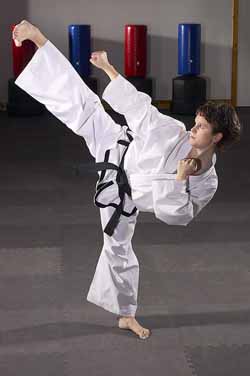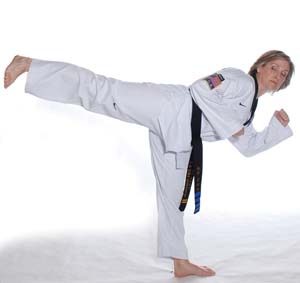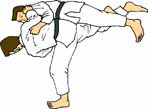 |
||||||
| ||||||
 |
The 5 Parts to Excellent Tae kwon do Kicking Techniques
General Tae kwon do kicking techniques follow these 5 phases.
There are adjustments to these phases, but basically speaking, all 5 steps make a complete kick. Some of these steps in execution are what make tae kwon do kicks different from other forms of martial arts.
Pivoting Foot
It is important to pivot the foot that remains on the floor so that the heel of the foot rotates around toward the target. You must develop this habit or run the risk of knee injury.
Knee Up Chamber
The kicking leg lifts with bent knee, straight up close to the chest. The knee does not raise to the side of the body like a dog.
Open Hip
Using the hips (rotating the hips into the kick) is what maximizes power and makes TKD kicks unique. It also extends your reach the width of your hips to target and finally, it lets you reach a higher target like the head.
Snap Back
This is also called a "rechamber". This helps you keep your balance, keeps your opponent from grabbing your leg and speeds up spinning kicks.
Finish
Don't just drop the leg to the floor like you're dropping a baseball bat. Rechamber the leg and lower the foot into fighting stance. This allows you to be ready for the next kick and helps complete combination kicks rapidly.
 |
Pride in your Country Tae Kwon Do T Shirts

USA TaeKwonDo

UK TaeKwonDo

Canada TaeKwonDo

Netherlands TaeKwonDo

Korea TaeKwonDo
Check out
The TKD Network Store
for more countries
FREE Tae kwon do Clipart
Get martial arts clipart like the one below! 50 + images available for your use. Click the Clipart button and follow instructions to get the password. Your email address will be added to our TkdTimes eZine mailing list.Find a topic...
Belts | Classes | Clipart | Forms | History | Injury Prevention | Kids | Martial Arts |Master | Meditation | Men
Olympic | Philosophy | Self Denfense | Styles | Tea | Techniques | Terminology | Tournaments | Women | Vegetarian
Copyright©
2008-2016 The Taekwondo Network. Always check with a physician before beginning any exercise regimen.
No reproduction of material without express written permission of the webmaster.
Taekwondo top of Page

